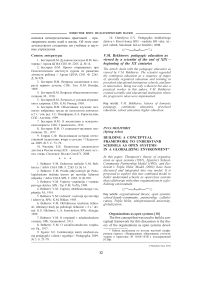Построение целостных концепций в средней школе как открытой системе в условиях глобализации
Автор: Molitoris Inna
Журнал: Известия Волгоградского государственного педагогического университета @izvestia-vspu
Рубрика: Педагогические науки
Статья в выпуске: 5 (109), 2016 года.
Бесплатный доступ
Для построения целостных концепций, стратегий и программ в средней школе представлена авторская модель на основе трех теорий: 1) Томпсона (1967) - об организациях как открытых системах, взаимодействующих с окружением и изменяющихся под внешним давлением; 2) Эрштейна (2001) - партнерство школы, семьи и местного сообщества для создания системы поддержки обучения школьников; 3) Ечковича (2003) - тройное взаимодействие и предпринимательские университеты. Данные теории предлагается рассматривать в их логической взаимосвязи в условиях глобализации рынка.
Организационная теория, открытые системы, школьное семейное сообщество, партнерство, сотрудничество, тройная спираль, предпринимательский университет, глобализация
Короткий адрес: https://sciup.org/148166578
IDR: 148166578
Текст научной статьи Построение целостных концепций в средней школе как открытой системе в условиях глобализации
Organizations as open systems [10]
The first concept that was used to build a conceptual framework for this discussion is the the ory of the organi zations as open systems devel-
oped by James Thompson in 1967. It can be surprising that 50 years ago, when the organizations went through industrialization process in which all seemed to be well organized, Thompson recognized the organizations–manufacturing firms, hospitals, schools, armies, community agencies– as extremely complex entities that lived in uncertainty. In his book, Organizations in Action , the researcher offered 95 distinct propositions about the behavior of organizations regardless of the culture in which they exist. Thompson’s theory is grounded in concepts in the social and behavioral sciences. While Thompson does not offer an actual theory of administration, his theory successfully extends the scientific base upon which any emerging administrative theory must rest [3]. Thompson (1967) describes the organizational change through the relationships between an organization and its environment.
The following figure demonstrates the key ideas of the organizational theory by Thompson ( Fig. 1 ).
The chart illustrates that any organization has Inputs, Transformational Process, and Outputs. As their Inputs, secondary schools have new students/pupils, their parents/guardians, new hired teachers and staff members, new technologies (policies and regulations) that constantly arrive to schools, and new information that reflects both, new knowledge in subject arears and knowledge about changes in society. A core system at an organization is what thatparticular organization does. It is an organizational Transformational Processthat transforms Inputsto Outputs. For example, newly admitted students graduate after going through education (transformation pro- cess), or newly hired teachers after being trained and utilized retire or leave the school because of any reasons. Core system is a central component of every organization, because it includes the processes that make the organization to physically exist. At schools, the core system refers to teaching/learning process, work in class, activities after school time, homework, and parent involvement. The Transformation Processes end with the Outputs that can be expressed in final exams, diplomas, school reports to the authorities,graduation rate, rate of acceptance to college, etc.
Feedback from the Outputs to the Inputs stimulates an ongoing flow of human resources, clients, information, and technical and technological change. If apply the Feedback to school, it may refer to the reputation of schools in their local communities. Local community awareness is built by the word of mouth and local advertising. Envi-ronment on the chart refers to those forces that affect an organization and pushthe organization to reflect by making adjustments and/or changes in its operation. Those adjustments and transformational changes may take place at the stages of Inputs , Transformation Process , and Outputs .
Based on how school leaders define their En-vironment or the main external force for changes, they react to that pressure and make changes to the direction that the Environment pushes-them to.The school administrators often see the government that frequently changes the rules, policies and procedures as the main force for changes and the main source of the constant uncertainty. However, there are other forces that exist in Environment but can be left unnoticeable, underes-
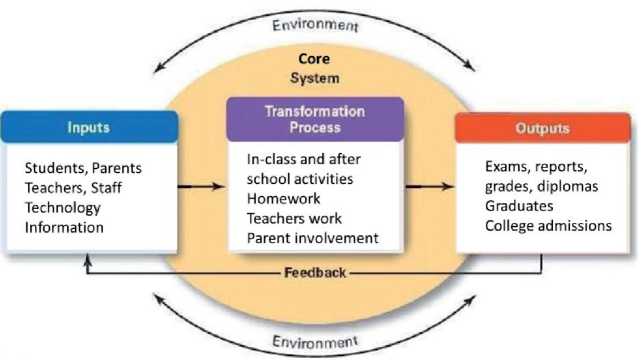
Fig. 1. Ѕchools as open systems [10]
timated, or simply ignored by school leaders because of lack of vision and understanding of interconnectedness.
Thompson’s (1967) theory explains that there are two distinct strategies of how schools react on the environmental pressure and seek survival paths. The closed-system strategy seeks certainty by incorporating only those variables positively associated with goal achievement. The opensystem organizations recognize organizational interdependence with environment. Their strategy shifts attention from goal achievement to survival and incorporates uncertainty.
Ѕince organizations are understood as people who work together to achieve common goals, people may have different attitude of dealing with uncertainty. Educational organizations are not different from any other industry, because all organizations are interdepended with their force environment regardless whether or not they recognize and accept that reality. Ѕchools may tend to be more or less open systems depending on chosen survival strategy and school leaders’ abilities to recognize and deal with uncertainty.
School-Family-Community Partnership Model [5]
The second theory that underpins the conceptual framework developed for this paper is the Ѕchool-Family-Community Partnership Model [5] that was introduced in the late 1980s by Joyce Epstein. The chart below demonstrates apartner-ship model adopted from the original work by Epstein.
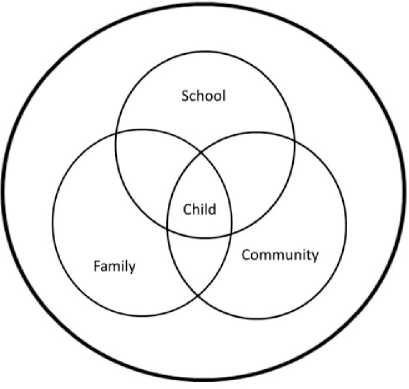
Fig. 2. Ѕchool-Family-Community Partnership Model
Epstein’s (2001) model has three main spheres: School, Family, and Community. These spheres are overlapping that represents that the interests and influences of the stakeholders in children’s education are mutual. Joyce Epstein developed six types of partnership to support collaboration between school, family, and community. These types are described below.
Type 1 – Parenting: Parenting includes all of the activities that parents engage in to raise happy, healthy children who become capable students.
Type 3 – Volunteering: There are three basic ways that individuals volunteer in education. First, they may volunteer in the school or classroom by helping teachers and administrators as tutors or assistants. Ѕecond, they may volunteer for the school; for instance, fundraising for an event or promoting a school in the community. Finally, they may volunteer as a member of an audience, attending school programs or performances.
Type 5 – Decision making: Parents and community leaders participate in school decision making when they become part of school governance committees or join organizations.
Type 6 – Collaborating with the Community: Ѕchool collaborates with communityorganizations, coordinates community resources and services for school students, families, and local organizations.
Epstein describes various levels of interactions. Traditional organizational interactions occur between families and schools. This kind of interaction received an extensive interest from researchers. The interactions between school and community organizations, specifically, business organizations, need to be explored in-depth in the context of a globalizing environment. Widely known African proverb that reflects Epstein’s model says that “It requires a village to raise a child.” In today’s globalizing world, a metaphor of a “village” should be expanded to a “global village.”
Triple Helix Model [6]
Etzkowitz (2003, 2004) discussed how the globalization shifts society toward a knowledge- based economy. In his work, Etzkowitz explores transformation processes that occur at higher education institutions worldwide. He stated that the “university retains the traditional academic roles of social reproduction and extension of certified knowledge, but places them to a broader context as part of its new role in promoting innovation” [6, p. 300]. The Triple Helix Model (Figure 3) developed by Etzkowitz (2003) exhibits the emergence of so called “entrepreneurial” universities in the areas of collaborations and tri-lateral networks that accompany these collaboration processes.
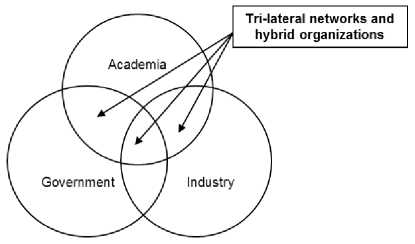
Fig. 3. Triple Helix model: Emergence of entrepreneurial university
The Triple Helix overlapping spheres of Academia , Government , and Industry also illuminate the contemporary situation, when a globalizing market and the increasing role of the federal government influence university missions and the role that they play in today’s society [9]. Etz-kowitz (2003) emphasized that the Triple Helix interaction is a key to “improving the conditions for innovations in a knowledge-based economy” (p. 295). The researcher argued that intellectual capital in the knowledge-based economy becomes as essential as financial capital and “financial capital is increasingly infused with knowledge” (p. 297).
Etzkowitz (2003, 2004) beliefs that today’s universities must fully participate in the market. The researcher acknowledges that there is still tension at many universities, because many traditional professors argue that the mission of the university originally was, and continues to be, teaching and conducting research. The new mission of the universities to participate in social and economic development also provokes resistance not only among faculty and staff, but society as a whole.
Constructing an Integrated Model
Connecting Thompson’s (1967) organizations as open systems theory with Epstein’s
(2001) Ѕchool-Family-Community Partnership Model and the Triple Helix model by Etzkowitz (2003) allows considering Global Environment [1; 2] as the existing powerful force that should not be left unnoticed neither ignored as educational leaders build strategy for their schools. Figure 4 below proposes to consider all three theories in relations with each other.
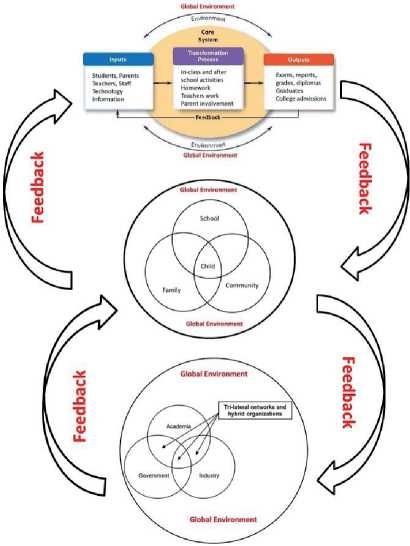
Fig. 4. Integrated model of schools that collaborate in a global environment
When educators implement Ѕchool-Family-Community Partnership Model [5], a holistic view of the environment should include the today’s reality on a global scale, the reality that is constantly changing and stays uncertain. Today, educational organizations are expected to be open systems to the higher degree than it was 50 years ago, when Thompson (1967) developed his powerful organizational theory. In the Triple Helix model, the role of the educational institutions should be more entrepreneurial [4; 6]; schools should stimulate interactions and exchanges between all spheres/ helixes to better prepare students to successfully move from secondary school to college and further to their professional lives. Those organizations that collaborate in the global environment may be recognized as “entrepreneurial” institutions that are searching their unique ways to survive and prosper.
Список литературы Построение целостных концепций в средней школе как открытой системе в условиях глобализации
- Altbach P. (2004). Globalization and the University: Myths and Realities in an Unequal World//Tertiary Education and Management, 10, 3-25.
- Ardichvili A., Cardozo R., & Ray S. (2003). A theory of entrepreneurial opportunity identification and development//Journal of Business Venturing, 18, 105-123.
- Atkins M., & Anderson A. (1999). Risk, Uncertainty and the Entrepreneurial Vision//Risk Management, 1, 35-48.
- Bird B. J. (1989). Entrepreneurial behavior. Glenview, Illinois: Scott, Foresman and Company.
- Epstein J. (2001). School, family and community partnerships: Your handbook for action. Thousand Oaks, CA. Corwin Press.
- Etzkowitz H. (2003). Innovation in innovation: The triple helix of university-industry-government relations//Social Science Information, 42, 293-337.
- Etzkowitz H. (2004). The evolution of the entrepreneurial university//International Journal of Technology and Globalisation, 1, 64-77.
- Hogan Jerry. (2006). School Administrator//The administrator’s guide to school-community relations. Alexandria, Va. American Association of School Administrators.
- Natale S.M., & Libertella A.F. (1998). Education-business partnership: Shifting sand in the university and corporate community//The Journal of Value Industry, 32, 257-268.
- Thompson J. (1967). Organizations in action. N. Y., NY: McGraw-Hill.

